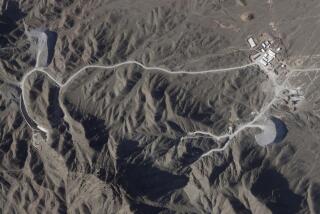Soviet ‘Star Wars’ Laser Facility Still Poses Threat, Pentagon Says
- Share via
WASHINGTON — The Pentagon on Wednesday said it remains convinced that a “Star Wars” laser facility in the Soviet Union poses a serious threat, despite the fact that an American delegation visited the site and concluded it to be “irrelevant.”
After reviewing a tape made Saturday by U.S. scientists and congressmen who toured the long-feared Sary Shagan Missile Center, Pentagon intelligence analysts dismissed the group’s contention that the facility’s lasers are incapable of destroying U.S. satellites.
“There is no change in our estimate of what the Soviets are up to or the capabilities of Sary Shagan,” Pentagon spokesman Lt. Col. Rick Oborn said. “As far as we are concerned, the videotape just confirms what we have been saying for four years now. The lasers at Sary Shagan, we believe, are capable of significantly damaging a satellite.”
The 10-member American delegation was organized by the Natural Resources Defense Council, an environmental group that favors arms control. The group maintains that the inspection of the complex’s laser found it would need to be 1,000 times more powerful to damage an orbiting satellite.
The scientists said their inspection of the center in Soviet Kazakhstan was prompted by “Soviet military glasnost ,” or openness, and was intended to allay Western fears of the weapons’ capabilities. But Frank Gaffney, a former Pentagon arms control adviser who now heads the Center for Security Policy here, contends that the team was duped and called their findings “irresponsible.”
Gaffney said it was “injudicious” to brand the center harmless after a “snapshot” visit that saw just “part of a much larger military capability” that is spread across the country’s vast expanse.
Using Soviet anti-satellite capability as a justification, the Pentagon is seeking $94.5 million this year for work on similar weaponry under the Strategic Defense Initiative, or “Star Wars,” program.
At a press conference Wednesday, scientists continued to maintain that the center lacks both the power and the cooling system to threaten U.S. satellites.
“The threat posed by this facility has been wildly inflated,” said John Pike, associate director for space policy at the Federation of American Scientists, who studied the videotapes and data brought back by the delegation. “The contrast with what we have been led to believe was there, and what was actually there, was so great that I had a hard time believing it.”
Council scientist Thomas Cochran, who toured the center, called its central computer a “museum piece” and said that, “in the 1960s, you could have bought this computer as (U.S.) Army surplus.”
The strongest laser at the center is about 1,000 times less powerful than a U.S. laser in New Mexico that is being used for anti-ballistic missile research, he said.
Jacob Scherr, an attorney with the council, said the evidence from the trip should “turn some American monsters back into midgets.”
Times staff writer Melissa Healy contributed to this story.
More to Read
Sign up for Essential California
The most important California stories and recommendations in your inbox every morning.
You may occasionally receive promotional content from the Los Angeles Times.













